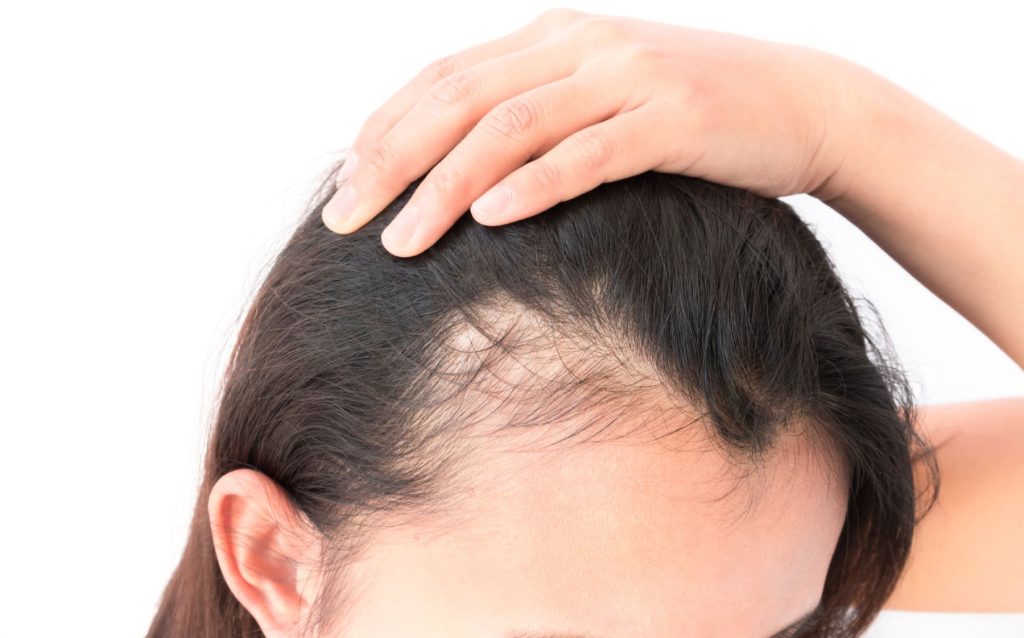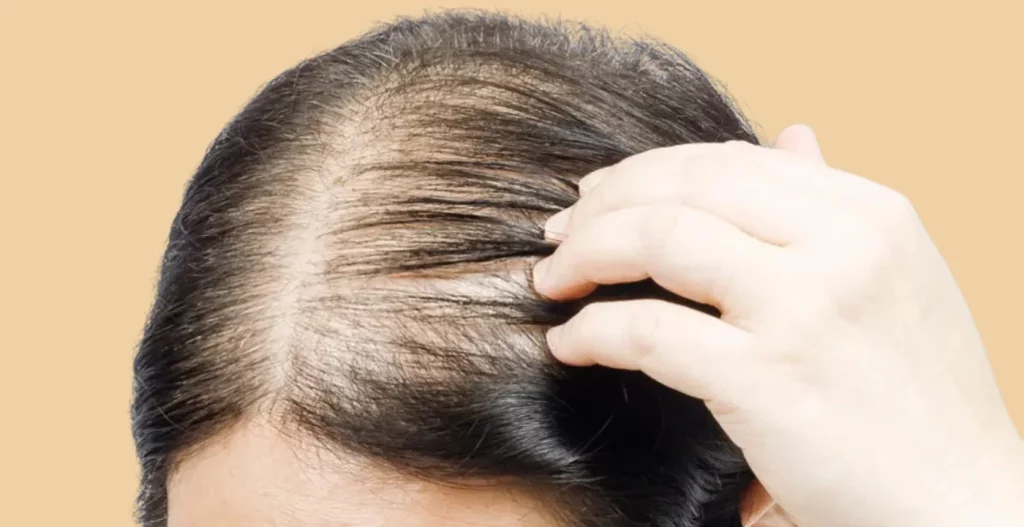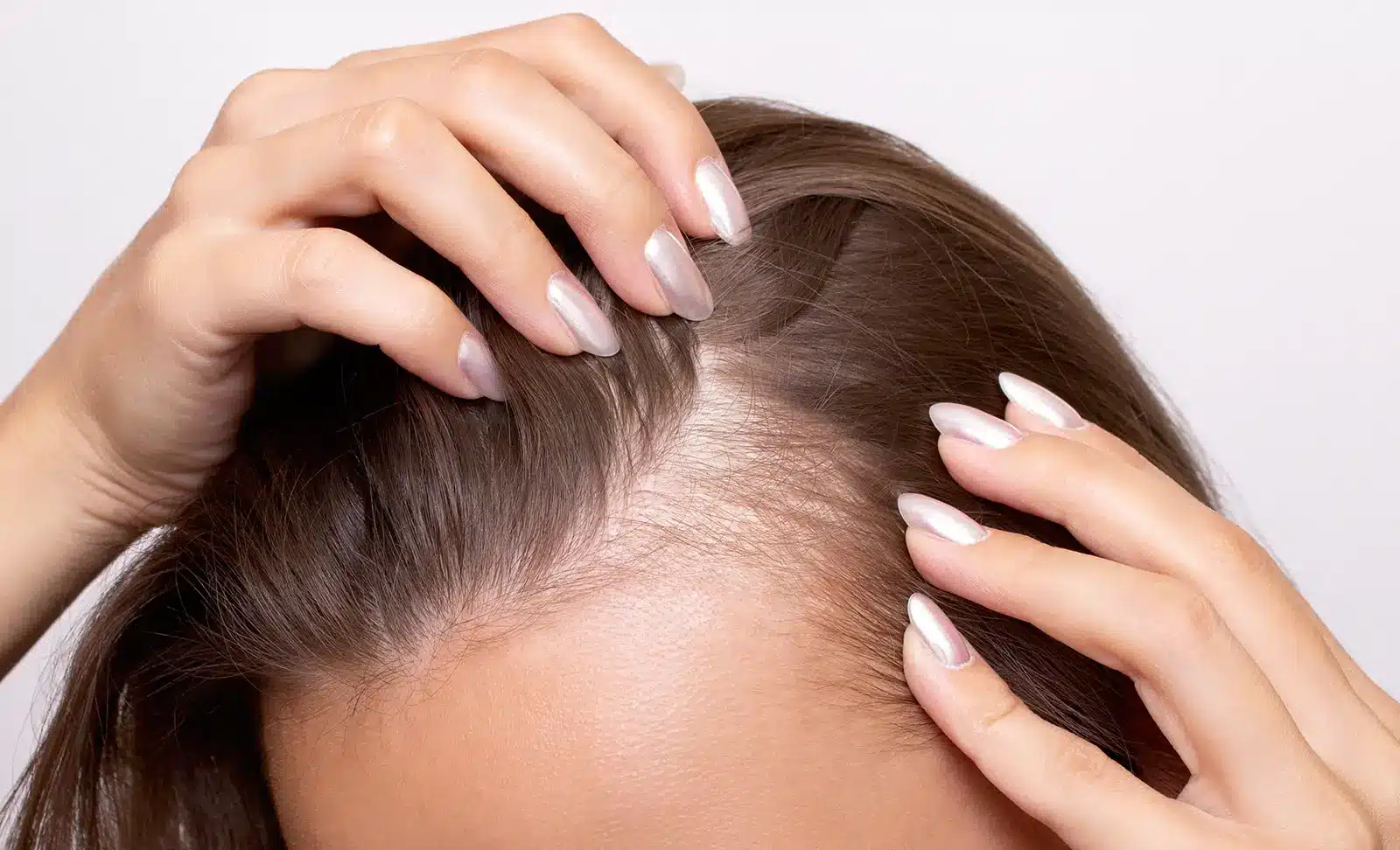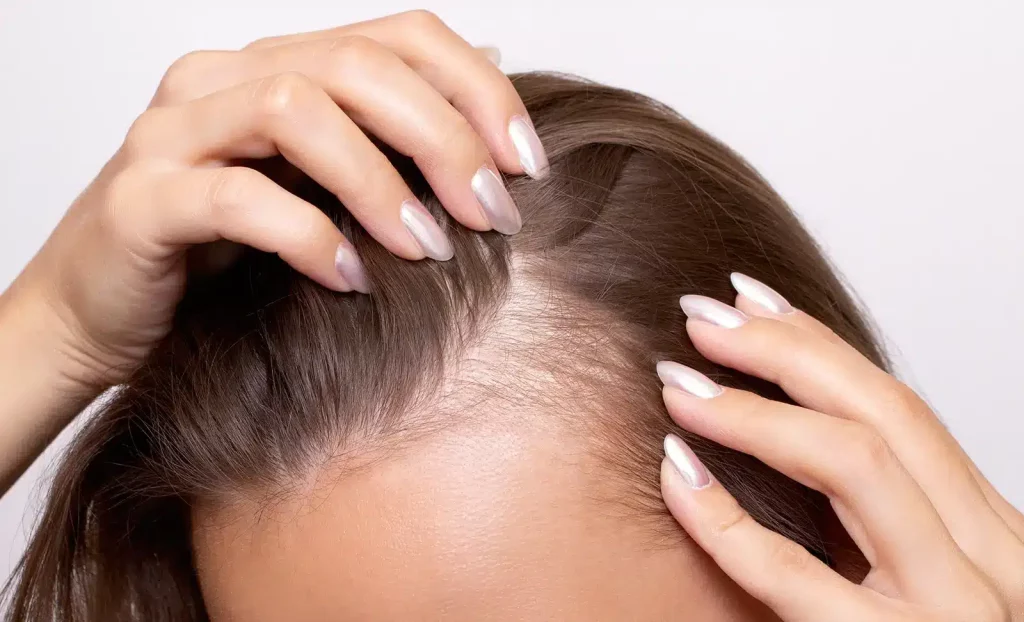Hair Loss in Women
Hair loss in women is defined as the loss of more than 125 hairs daily, leading to issues such as shedding, bald patches, and thinning hair. Consulting a dermatologist can help identify the underlying causes of hair loss and suggest appropriate treatment options.
What is hair loss in women?
Hair loss in women refers to the unexpected and significant shedding of hair. Typically, individuals lose between 50 and 100 hairs each day as part of a natural cycle where some hairs fall out while new ones grow in. Disruption of this cycle, where hair loss exceeds regrowth, results in hair loss, medically known as “alopecia.”
Hair is present on nearly all skin surfaces, excluding the palms, soles, lips, and eyelids. The fine, light hair is termed vellus hair, while thicker, darker, and longer hair is referred to as terminal hair.
What are the cycles of hair growth?
Hair growth occurs in three distinct phases:
1. The anagen phase (growth phase) can last from two to eight years and encompasses approximately 85% to 90% of the hair on the scalp.
2. The catagen phase (transition phase) is when hair follicles begin to shrink, lasting about two to three weeks.
3. The telogen phase (resting phase) lasts around two to four months, culminating in the shedding of hair.
Shorter hairs, such as eyelashes, arm and leg hair, and eyebrows, have a brief anagen phase of about one month, while scalp hair can remain in the anagen phase for up to six years or even longer.

What are the types of hair loss in women?
Women typically experience three main types of hair loss:
1. Androgenetic alopecia, also known as female pattern alopecia or female pattern hair loss (FPHL), is the most prevalent form. It is characterized by thinning hair on the crown and sides of the head.
2. Anagen effluvium occurs when medications disrupt the growth of hair follicles, with chemotherapy being a common example.
3. Telogen effluvium results from an increased number of hair follicles entering the telogen phase, which is the stage where hair begins to shed.
How prevalent is hair loss among women?
Contrary to popular belief that hair loss primarily affects men, research indicates that over 50% of women will experience noticeable hair loss at some point. The leading cause of this condition is female-pattern hair loss (FPHL), which impacts approximately 30 million women in the United States.
Symptoms and Causes
What are the indicators of hair loss in women?
Indicators of hair loss in women may consist of:
- Increased daily hair shedding.
- Visible areas of thinning or absent hair, particularly a widening part on the crown of the head.
- Scalp visibility through the hair.
- The need for smaller ponytails.
- Experiencing hair breakage.
What are the reasons for hair loss in women?
Hair loss in women can be attributed to various factors, including:
- Damaged hair follicles.
- Dietary changes (such as rapid weight loss).
- Stress levels.
- Chemical hair treatments.
- Medical treatments like chemotherapy or radiation.
- Underlying health issues, such as thyroid disorders, anemia, or vitamin deficiencies.
- Hormonal fluctuations (related to pregnancy or menopause).
- Certain medications and supplements (including blood pressure medications, gout treatments, and high doses of vitamin A).
- Genetic factors (a family history of hair loss).
What is the connection between hair loss in women and menopause?
During menopause, your body undergoes various changes that can impact your hair, leading to:
- New hair growth in areas where it previously did not occur.
- Thinning of existing hair.
These alterations are primarily due to fluctuating hormone levels associated with menopause.
Additionally, the size of your hair follicles decreases, resulting in finer (thinner) hair growth.
What are the risk factors for hair loss in women?
Hair loss can affect women of all ages, but it is more prevalent among those with a family history of the condition and/or after certain life events, including:
– Age 40 and above.
– Pregnancy.
– Chemotherapy or radiation therapy.
– Menopause.
Diagnosis and Tests
How does a healthcare provider diagnose hair loss in women?
A healthcare provider will conduct a comprehensive examination and gather a detailed medical history to assess changes in your hair growth. They will inquire about any medications or supplements you are currently taking, and further tests may be recommended following the initial evaluation.
What tests diagnose hair loss in women?
The tests to diagnose hair loss in women may include:
- A gentle tug on the hair to assess how many strands fall out.
- A microscopic examination of the scalp.
- Blood tests to evaluate levels of vitamins and minerals (such as vitamin D, vitamin B, zinc, and iron) as well as hormone levels (including thyroid hormones).
- A scalp biopsy to collect and analyze a small sample of scalp tissue.
What inquiries might your healthcare provider make to assess hair loss?
To evaluate hair loss, your healthcare provider may pose questions regarding your hair care practices, such as:
- What types of hair products do you use?
- What hairstyles do you typically wear?
- Do you have a tendency to pull your hair out (trichotillomania)?
They may also inquire about your medical history, including:
- Has anyone in your immediate family experienced hair loss?
- Are there any stressful situations currently affecting your life?
- What medications and supplements do you take regularly?
- Have you experienced hair loss in the past?
- What does your diet consist of?
Additionally, they might ask about your personal observations, such as:
- How long have you been experiencing hair loss?
- Have you noticed an increase in shedding?
- Have you observed hair loss in areas other than your scalp, like your eyebrows or body hair?
- Are there any factors that seem to exacerbate your hair loss?
- Are there any factors that appear to improve your hair loss?
- Is your hair loss sporadic or has it been persistent?
- Have you noticed any changes in your hair growth?
- Has your hair been breaking more frequently?
Management and Treatment
What are the options for treating hair loss in women?
The approach to treating hair loss varies based on its underlying cause and may involve:
– Reducing stress levels, potentially through consultations with a mental health professional.
– Avoiding hair products, such as chemical treatments, that can harm your hair.
– Taking vitamins or supplements to address any deficiencies.
– Modifying your hairstyling practices to protect your hair follicles.
– Using medications as prescribed.
– Managing any existing health issues.
Additionally, a healthcare provider may suggest light therapy options, such as the HairMax Lasercomb®, which is FDA-approved for treating Female Pattern Hair Loss (FPHL). Another FDA-approved option is the Theradome LH80 PRO® helmet, along with other low-light laser devices.
If your hair loss is linked to stress or hormonal changes, such as those occurring during pregnancy, treatment may not be necessary, as the hair loss typically resolves on its own over time.
Other treatment methods may include:
– Scalp microneedling, with or without minoxidil application.
– Injections of platelet-rich plasma (PRP) to stimulate hair growth.
– Hair transplant surgery.
It is crucial to consult with your healthcare provider before initiating any hair loss treatment, as certain options may not be safe during pregnancy, if you are planning to conceive, or while experiencing menopause.
What medications are available for treating hair loss in women?
A healthcare professional may suggest minoxidil (Rogaine®), which is approved for the treatment of female pattern hair loss (FPHL). This medication is available in 2% and 5% solutions over the counter (OTC). It is essential to adhere strictly to the usage instructions and continue using the product indefinitely. Pregnant women, those planning to become pregnant, or breastfeeding mothers should avoid this treatment.
Other medications that may be effective for hair loss in women include:
- Spironolactone and other anti-androgens
- Finasteride and other alpha-reductase enzyme inhibitors
- Estrogens
- Prostaglandin analogs
- Steroids
What are the potential side effects of minoxidil?
Minoxidil can cause scalp irritation, leading to dryness, scaling, itching, and/or redness. If you experience these symptoms, consult your dermatologist.
Additionally, minoxidil may result in hair growth in unintended areas, such as the cheeks and forehead. It is advisable to wash your face after applying minoxidil and to avoid contact with other areas during application.

Who specializes in treating hair loss in women?
Typically, a dermatologist is the specialist who addresses hair loss issues in women.
Prevention
Is it possible to prevent hair loss in women?
While not all instances of hair loss in women can be prevented, you can avoid hair loss resulting from chemical treatments by refraining from their use. Maintaining a nutritious diet rich in essential nutrients (such as vitamins, minerals, and protein) or incorporating vitamin supplements into your daily routine may help mitigate some hair loss.
What is the outlook for hair loss in women?
The prognosis for hair loss in women largely depends on the type and severity of the condition. Certain types of hair loss can be permanent, particularly if there is damage to the hair follicles. However, not all cases are irreversible; for instance, anagen and telogen shedding may resolve over time. Addressing any underlying health issues can improve hair loss, and early intervention for alopecia may slow down thinning and encourage regrowth. A healthcare provider can offer more specific insights regarding your individual situation.
Living With
What strategies can help manage hair loss?
There are several approaches you can take to cope with hair loss and enhance your comfort, such as:
- Altering your hair color. Applying dye can create the illusion of increased volume, making your hair appear thicker.
- Massaging your scalp. While washing your hair, use your fingertips to massage your scalp, which can promote blood circulation to your hair follicles.
- Changing your hairstyle. Opting for a shorter cut or experimenting with layers and new styling methods can elevate your confidence and help conceal any thinning areas.
- Exploring various shampoos and hair products. Seek out shampoos that provide volume without harsh sulfate detergents.
When should I consult a healthcare professional?
It is advisable to see a dermatologist promptly upon noticing hair loss. Early intervention can lead to more effective treatment outcomes.
What inquiries should I make to my healthcare provider?
Consider asking your provider the following questions:
- What is causing my hair loss?
- How many hairs am I losing daily?
- What type of hair loss am I experiencing?
- Is my hair loss likely to be permanent?
- What treatment options are best suited for me?
A message from Clients
Although hair loss is not a medical threat, it can be an emotionally challenging experience. Unwanted changes in appearance can affect self-esteem and social interactions. Some individuals find it helpful to speak with a mental health professional if their hair loss leads to distress, while others may find solace in altering their hairstyle or using a wig.




